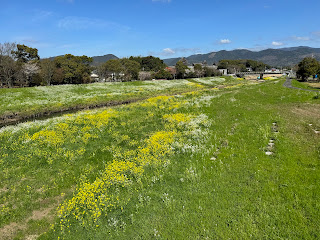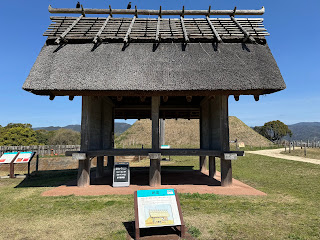After leaving the hotel we drove to Yoshinogari Historic Park, located in the hilly area that spanned Kanzaki City and Yoshinogari Town. From around 1970s small-scale excavations were conducted in the area due to redevelopment of farmland, with a bigger archaeological excavation started in 1986. Finally, the site was designated as a Special Historic Site in 1991, with the preservation began soon after, developing into the current historic park which opened to public in 2001.
Arriving at the East Entrance and paying the entry fee (460 yen for adult), we decided to follow the Yayoi Path per the guide map, as the historic park and its adjacent prefectural park was huge, with a total area of 105.6 hectares. Walking across the Floating Bridge of Heaven, the full blossoms of the flowers along the river, and the beginning of the blooming of cherry blossoms along the path clearly signalled the onset of Spring.
At the Moat-Encircled Village Entrance, there was moat and stakes (called Sakamogi) serving as barricades at such strategic areas, to protect the people living inside the village.
At the Southern Inner Enclosure, there was a Gate Tower with guards stationed, allowing them to watch the people entering and leaving the enclosure.
The Watchtower was a much higher structure, allowing soldiers to monitor the surrounding areas from a high vantage point.
Climbing up the watchtower, one could appreciate how far the soldiers could see. With the sunny weather and cool temperature, staying there to enjoy the light breeze was a treat on its own.
There were a number of houses in the village re-constructed to illustrate the life of the people in the Yayoi period. One was the house of the wife of the Taijin (the ruling class), who was responsible for military affairs and building works.
Another was the residence of the ruling class, who played the role of supervision and administrative activities of the village.
The King’s House, as its name suggested, was where the ruler of the village and his family lived.
There were also the kitchens, believed to be where communal cooking was conducted. No traces of cooking inside the pit dwellings had been found, showing that the people did not cook at their house.
The Hall of Assembly was a large building with an atrium opposite to the King’s House, believed to be where the ruling class gathered to discuss matters.
In the Northern Inner Enclosure, there were houses serving more specific purposes, like brewery, sericulture and weaving.
Some of the houses were believed to have raised floor, serving
as warehouses for valuable items like tools and treasures used for rituals.
There was also a section more dedicated to the worship and cultural activities, including the Shrine, Residence for High-Priest, and the Main Ceremonial Hall.
Continuing on there were rows of burial jars, called kamekan, a type of coffin unique to northern Kyushu, which had been widely used for about 200 years during the mid-Yayoi period.
Further on was the North Burial Mound, believed to be where the kings of Yoshinogari village were buried. The mound was an artificially constructed hill, with 14 coffins found inside, where some containing glass beads and bronze swords with ornaments.
The burial process and a model of the kamekan was displayed to show how the deceased was positioned in the coffin.
In the Exhibition Room many earthenware were on display, along with the clothing of people during the Yayoi period. It was surprising to see how colourful and intricate those were.
Address: 神埼郡吉野ヶ里町田手1843
Telephone: 0952-55-9333
Website: https://www.yoshinogari.jp/





































沒有留言:
張貼留言